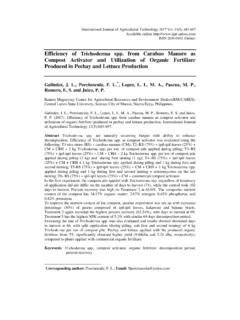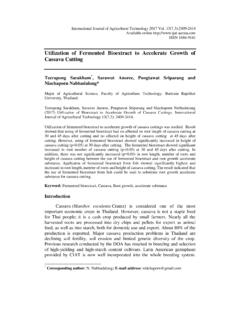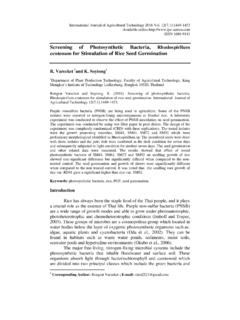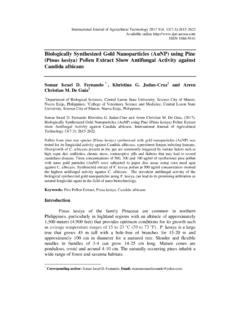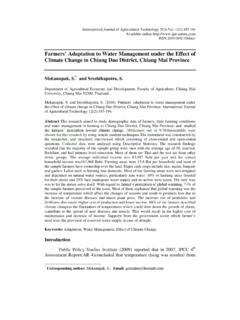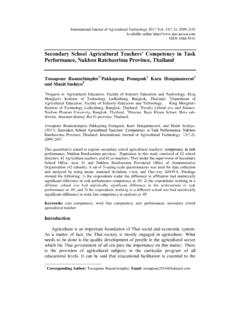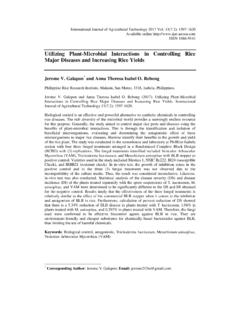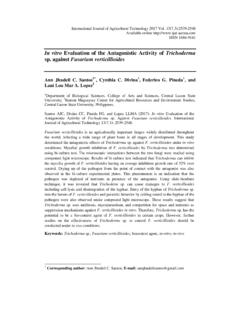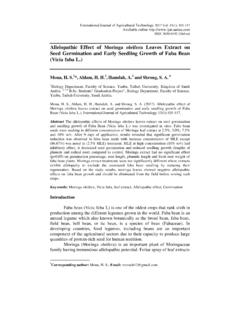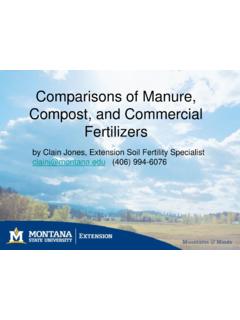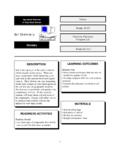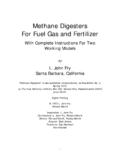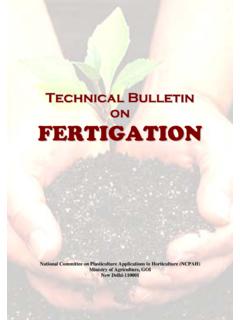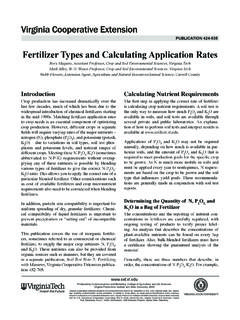Transcription of Nutrient Use Efficienty, Yield and Fruit Quality of …
1 International Journal of Agricultural Technology 2017 Vol. 13( ): 1413-1435 Available online ISSN 1686-9141 Nutrient Use Efficienty, Yield and Fruit Quality of Sweet Corn (Zea mays saccharata Sturt.) Grown Under Different Fertilizer Management Schemes Capon, *, Nitural, and Dela Cruz, 1 Visayas State University, Visca, Baybay City, Leyte, Philippines and 2 Central Luzon State Univeristy, Science City of Munoz, Nueva Ecija, Philippines. Capon, , Nitural, P. S. and Dela Cruz, (2017). Nutrient Use Efficiency, Yield and Fruit Quality of Sweet Corn (Zea mays saccharata Sturt.) Grown Under Different Fertilizer Management Schemes. International Journal of Agricultural Technology 13( ): 1413-1435.
2 Proper fertilizer management strategy is a very important consideration for optimizing crop productivity, food production sustainability, maximizing farm economic returns, and reducing adverse impacts of nutrients on soil fertility, health and the environment. A field experiment was conducted to evaluate the Nutrient efficiency, Yield and nutritive Quality of sweet corn grown under different fertilizer management schemes in Baybay City, Leyte, Philippines. The treatments were: Main plot- sweet corn variety: Sweet Pearl and Sweet Grande; and Sub-plots- fertilizer management schemes: T1 control, T2 conventional fertilizer management scheme (CFMS), T3 organic fertilizer management scheme (OFMS), T4 organic based fertilizer management schemes 1 (OBFMS1), T5 organic- based fertilizer management scheme 2 (OBFMS2), and T6 organic-based fertilizer management scheme 3 (OBFMS3).
3 The study was done in a Split Plot Design with three replications arranged in Randomized Complete Block Design (RCBD). Results showed that growth parameters (plant height, leaf area, growth rate, and dry matter Yield ) and Yield and Yield components (ear height, ear width, weight of ear/plant with and without husk, fresh ear Yield /plot with and without husk, and stover) were significantly increased with application of organic (OFMS), organic-based (OBFMS) and conventional (CFMS) fertilizer management schemes. Application of CFMS resulted to highest increase in starch and sugar content, while application of OBFMS2 gave the highest protein content in the sweet corn use efficiency of Sweet Pearl was higher ( ) than that of Sweet Grande ( ) because of higher N recovery efficiency.
4 Decrease in nitrogen use efficiency was attributed to low physiological efficiency as levels of nitrogen fertilizer increased. The highest P and K recovery efficiency, physiological efficiency and use efficiency among different rates of P and K (kg ha-1) were observed when applied at rates of 30 and 60 kg ha-1 for Sweet Pearl and Sweet Grande. Results also revealed a decreasing pattern in P and K use efficiency values with increasing rates of P and K application indicating that maximum crop production can be attained with lower fertilizer applications. Keywords: Nutrient use efficiency, fertilizer management schemes, Fruit Quality * Corresponding Author: Dr.
5 Daisy S. Capon; Email: 1414 Introduction Sweet corn is classified as one of the most promising high valued horticultural crops because of its short maturity and faster economic returns particularly for small farmers. Nowadays, sweet corn has been grown commercially, it is a profitable farming enterprise and a good cash crops with high year- round price (Domingo and Hagerman, 1983). The kernels are usually eaten fresh in cob and are used as ingredients in most food preparations and can also be processed as canned products. Sweet corn has a short growth duration, thus, farmers can grow four or more croppings a year.
6 There is high demand for sweet corn in the market and is expected to increase in the future. Thus, development of production technologies is needed to meet the increasing demand in the market. Proper fertilizer management strategy is very important consideration for optimizing crop productivity, food production sustainability, maximizing farm economic returns, and reducing adverse impacts of nutrients on soil fertility, health, and the environment (Dela Cruz, 2015). With the adverse effects of continued and excessive use of inorganic fertilizer, the productivity of the soil declines as well as its overall health soil, and the environment.
7 To address this problem, government pushes organic agriculture by using alternative organic fertilizer like vermicompost and fermented plant extracts that are commercially available. This technology is a sustainable solution for management of organic wastes which are major sources of environmental pollution (Lazcano et al., 2012). Hence, this study was conducted to evaluate the effects of different fertilizer management schemes on the growth, Yield , and Quality parameters in two sweet corn varieties and determine the effects of different fertilizer management schemes on Nutrient use efficiency in two sweet corn varieties.
8 Materials and Methods Location and History of the Experimental Area The study area was located at the research experimental site of PhilRootCrops, Visayas State University, Visca, Baybay City, Leyte, Philippines (10 45' "N 124 47' "E). The climate is characterized with rainfall that is evenly distributed throughout the year (Type IV). The experimental area was previously grown with sweet potato (germplasm project) every year. Land Preparation International Journal of Agricultural Technology 2017 Vol. 13( ): 1413-1435 1415 The area was plowed twice and harrowed by tractor 3 times at one week interval to thoroughly decompose plant residues and have good soil tilth.
9 Thirty six (36) plots with dimensions of 5m x 6m were prepared and small canals (20cm x 20cm) which served as drainage were constructed along the side of the raised beds. Soil Sampling One (1) kilogram of composite soil samples was collected after land preparation using standard soil sampling procedure. The samples were then air-dried, sieved, packed, labeled, and submitted for analyses to the Central Analytical Services Laboratory, Visayas State University, Visca, Baybay City, Leyte, Philippines. Seed Sowing and Seedling Management Seeds of sweet corn varieties, Sweet Pearl and Sweet Grande, were separately sown in 50-cells plastic trays filled with sterilized germination medium containing 1:1 ratio of carbonized rice hull and vermicast.
10 Plastic trays containing the sown seeds were arranged in an enclosed improvised screen house for protection against astray animals and adverse environmental conditions. A prepared starter solution containing 10 g of urea (45-0-0) dissolved in 4 liters of water was sprayed to the seedlings two (2) days after emergence (DAE). Watering was done whenever necessary and monitoring of presence of insect pests and diseases was done daily. Soil drenching of fungicide was done on seedlings when first symptoms of damping-off disease occur. The seedlings were hardened by gradually exposing the trays to direct sunlight at 6-8 days after sowing (DAS).
